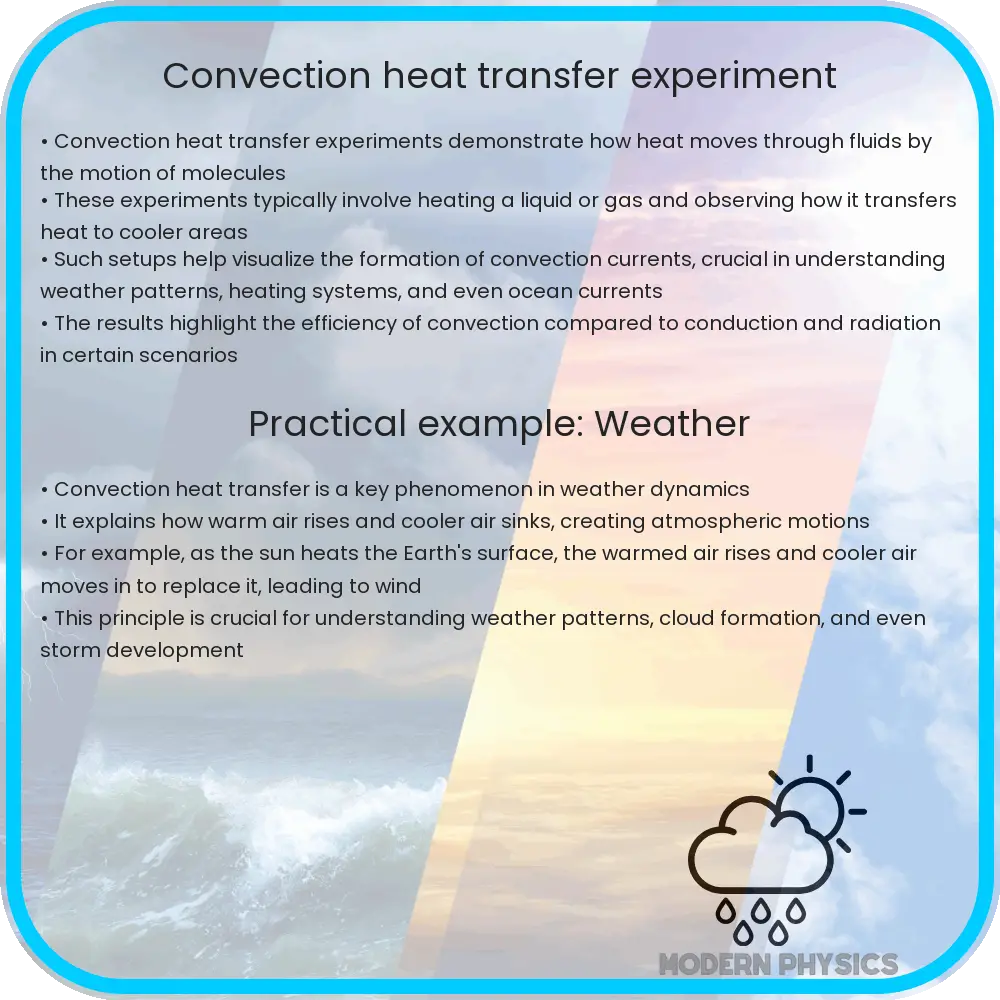Explore the essentials of convection heat transfer through experiments, efficiency analysis, and real-world applications in this insightful article.

Understanding Convection Heat Transfer: An Experimental Approach
Convection heat transfer is a fundamental concept in thermodynamics, playing a crucial role in various industrial processes and everyday applications. This article delves into an experimental exploration of convection heat transfer, its efficiency, methods, and analytical techniques.
The Basics of Convection Heat Transfer
Convection involves the transfer of heat through a fluid (liquid or gas) caused by molecular motion. This process can be natural, driven by buoyancy forces due to temperature differences, or forced, where external means like a fan or pump induce fluid motion.
Experimental Setup for Studying Convection
The experimental study of convection requires a controlled setup that typically includes a heat source, a fluid medium, temperature sensors, and data acquisition systems. The heat source could be an electrically heated plate or rod immersed in the fluid. Temperature sensors are strategically placed to measure the temperature gradient, crucial for analyzing the heat transfer process.
Measuring Efficiency in Convection Heat Transfer
Efficiency in convection heat transfer experiments is assessed by comparing the input energy (from the heat source) to the energy absorbed by the fluid. High-efficiency convection implies a significant portion of the input energy is effectively transferred to the fluid.
Methods of Convection Heat Transfer Analysis
There are two primary methods for analyzing convection heat transfer: qualitative and quantitative. Qualitative analysis involves observing the physical behavior of the fluid, like flow patterns and temperature distribution. Quantitative analysis, on the other hand, relies on mathematical models and equations. The Nusselt number (Nu), a dimensionless parameter, is often used to characterize convection heat transfer. It’s defined as:
Nu = hL/k
where h is the convective heat transfer coefficient, L is the characteristic length, and k is the thermal conductivity of the fluid.
Advanced Techniques in Convection Analysis
Advanced experimental techniques, like Particle Image Velocimetry (PIV) and Laser Doppler Anemometry (LDA), are used for detailed analysis. These methods allow for precise measurements of fluid velocity and temperature gradients, essential for a comprehensive understanding of convection phenomena.
Understanding the nuances of convection heat transfer through experimentation not only advances scientific knowledge but also has practical implications in engineering and technology.
Applying Computational Tools in Convection Experiments
In addition to experimental methods, computational tools play a significant role in studying convection heat transfer. Computational Fluid Dynamics (CFD) simulations offer a detailed insight into fluid flow and heat transfer, complementing physical experiments. These simulations help in visualizing complex flow patterns and temperature fields that are difficult to measure experimentally.
Challenges and Solutions in Convection Heat Transfer Experiments
Conducting convection experiments involves several challenges, such as ensuring accurate temperature measurements and maintaining stable flow conditions. Solutions include the use of high-precision sensors and the implementation of controlled environments to minimize external influences. Additionally, ensuring consistent and repeatable experimental conditions is crucial for reliable results.
Case Studies: Real-World Applications
Real-world applications of convection heat transfer experiments span across various fields. In the HVAC industry, these experiments help in designing more efficient heating and cooling systems. In the automotive sector, they assist in improving engine cooling systems. Furthermore, in the renewable energy domain, studies on convection contribute to the development of more efficient solar panels and wind turbines.
Future Directions in Convection Heat Transfer Research
Future research in convection heat transfer is geared towards integrating more advanced analytical tools and exploring new materials with enhanced thermal properties. There’s also a growing interest in studying convection in microgravity environments, which has significant implications for space technology.
Conclusion
The experimental study of convection heat transfer is a field rich with practical applications and scientific inquiry. By combining traditional experimental methods with advanced computational techniques, researchers continue to deepen our understanding of heat transfer processes. This knowledge not only drives technological innovations but also contributes to more energy-efficient and sustainable solutions in various industries. As we move forward, the ongoing advancements in this field promise to further revolutionize our approach to managing and utilizing thermal energy in diverse applications.
